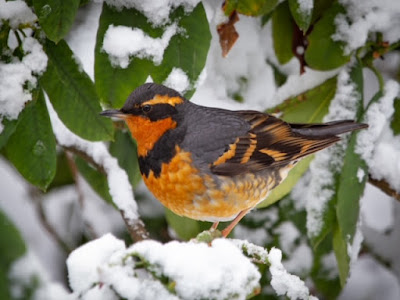For the Birds: Pacific Northwest Christmas Bird - the Varied thrush
Tuesday, December 14, 2021
Much of the U.S. recognizes the Northern Cardinal as the Christmas Bird due to its bright red coloring.
But we in the western US do not have Northern Cardinals. Southern Arizona has some, but that is as close as they come to the rest of the West.
When an area doesn’t have the most recognized U.S. Christmas bird symbol in their area, what is the alternative?
We could pick one that does hang out in our area during the winter months.
We don’t really have any winter birds with much red, or green for that matter. Sure, we have Spotted Towhees with their rufous sides, Pileated Woodpeckers with their red caps, Red-breasted Sapsuckers with their red heads, even some American Robins, but a distinctive bird that is just a winter visitor would be preferable.
Varied Thrushes fit the bill. Their coloring is so impressive they could be a Christmas ornament, and their ethereal winter song can stop you with delight.
The females have the same pattern, but her back is brown rather than slate-color, so the overall impression of the female is “What is that orange-ish bird?”
We don’t really have any winter birds with much red, or green for that matter. Sure, we have Spotted Towhees with their rufous sides, Pileated Woodpeckers with their red caps, Red-breasted Sapsuckers with their red heads, even some American Robins, but a distinctive bird that is just a winter visitor would be preferable.
 |
| Female in snow photo by Craig Kerns |
They are in the same family as American Robins, but more vividly colored.
The male has a burnt-orange stripe above his eyes that match his vivid breast and belly.
The male has a burnt-orange stripe above his eyes that match his vivid breast and belly.
He has a wide black necklace, and his head, back and tail are a bluish slate color.
If that isn’t enough to make it look like an ornament, the wings are a bold pattern of slate, black and orange.
 |
| A male Varied thrush forages on the ground Photo by Craig Kerns |
The necklace on some females is hard to see — but it is there.
Varied Thrushes breed at higher elevations and come down to our area during winter months looking for seeds and berries.
As a Pacific Northwest bird, they particularly like dense forests and bushes, especially near streams, but they will sometimes dart out into yard opening during the winter.
In the wintertime Varied Thrushes will eat from ground feeders. Planting native fruiting shrubs is also a good way to attract them into your yard.
As a Pacific Northwest bird, they particularly like dense forests and bushes, especially near streams, but they will sometimes dart out into yard opening during the winter.
In the wintertime Varied Thrushes will eat from ground feeders. Planting native fruiting shrubs is also a good way to attract them into your yard.
 |
| Male and female foraging on the ground A yard with native plants will often have a pair Photo by Craig Kerns |
Snowberries are an easy plant to grow. The white berries throughout the winter add interest to an otherwise drab yard, and once there has been a frost, Varied Thrushes and Spotted Towhees will eat those berries. Often while foraging you’ll hear a cute little “Chuck,” “Chuck.”
Maybe your yard will have our PNW Christmas Bird this year.
Maybe your yard will have our PNW Christmas Bird this year.





0 comments:
Post a Comment